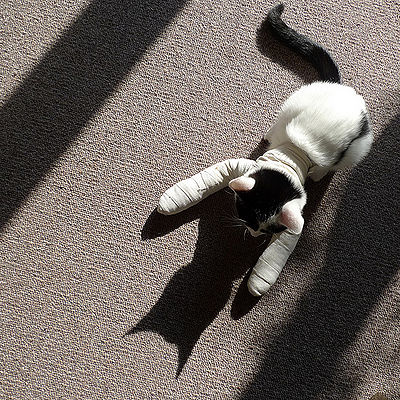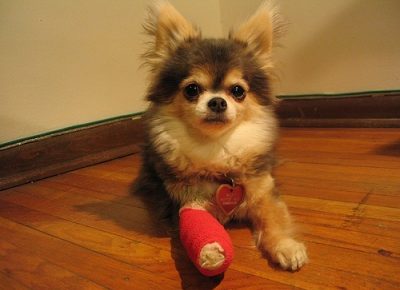
When you face an emergency situation, remember, don’t panic, stay calm. If you are at home, always keep your First Aid Kit easily accessible.
Procedures for an injured pet – Approach the animal cautiously. Speak calmly and softly. If you must restrain the animal, use a leash, a belt, a rope or a piece of clothing. Form a noose and drop it over the animals head.
Check for the following – heartbeat (left side of chest), breathing, bleeding, are gums pale, any visible fractures. Call your vet or emergency group and give them as accurate information as you can.
If breathing is irregular or non-existent, apply artificial respiration.
For bleeding, apply a gauze pad or a piece of material to the injury and bind it, but not too tightly. If bleeding doesn’t stop, apply pad and bind firmly to these pressure points depending on where the injury is located – front leg, above the inner elbow; back leg, upper inner thigh; underneath the tail; head and neck, where the carotid artery meets the shoulder (you’ll need to use your finger for this).If you can the wound should be flushed with water to remove any debris. If possible, elevate the wound. Clip the hair around the wound, making sure no hair enters the wound. Vaseline or KY jelly can be applied to the hair to make it easier. A Telfa pad applied won’t stick to the wound, so it’s a good idea to add them to your emergency kit. Check for normal breathing, vomiting or diarrhea.
Move an injured pet as gently as possible. Spread a blanket or coat or some cloth behind the pet. The head, back and pelvis need to be supported. If you have help, you can move the pet to the blanket, supporting the body. If you are alone, move one part of the body at a time to the blanket. Gently carry the pet to your car. If you don’t have transportation, call emergency services immediately.
For burns, gently rinse the area with cold water. Apply petroleum jelly or burn ointment.
For an eye wound, soak a sterile pad in warm water, not dripping, place over the eye and gently bind.
For a fractured limb, wind 2 or 3 layers of cotton batting or material around the limb. If you have something to use as splints, bind them in place with bandage or strips of cloth.
For drowning – a small pet can be lifted by its back legs; hold upside down and swing carefully. For a large pet, lift behind the ribs and drape over your shoulder, opening its mouth and pumping the chest.
For choking – If a foreign body becomes lodged in the mouth or throat, restrain the animal, open the mouth and try removing the object with your fingers. If this doesn’t work, try the method for drowning.
Heatstroke – clear froth from the mouth. Douse the entire body with cold water. Take the animal immediately to your vet or emergency services.
Poisons – if you know what your pet has swallowed, bring it with you and go to your vet or emergency services immediately.
Convulsions – make sure the animal is in a safe place. Generally, convulsions don’t last more than 5 minutes, so avoid touching the animal. Call your vet immediately.
Shock and collapse – do not administer any medications or alcoholic beverages. Keep the animal warm. Contact your vet immediately.
In all cases, these are just very temporary measures. If you are not sure what to do, don’t touch the animal. Call your vet or emergency services immediately in all cases. These emergencies require expert and immediate attention. Give as much information as you can until help arrives or you are able to transport the animal.
Related Articles



